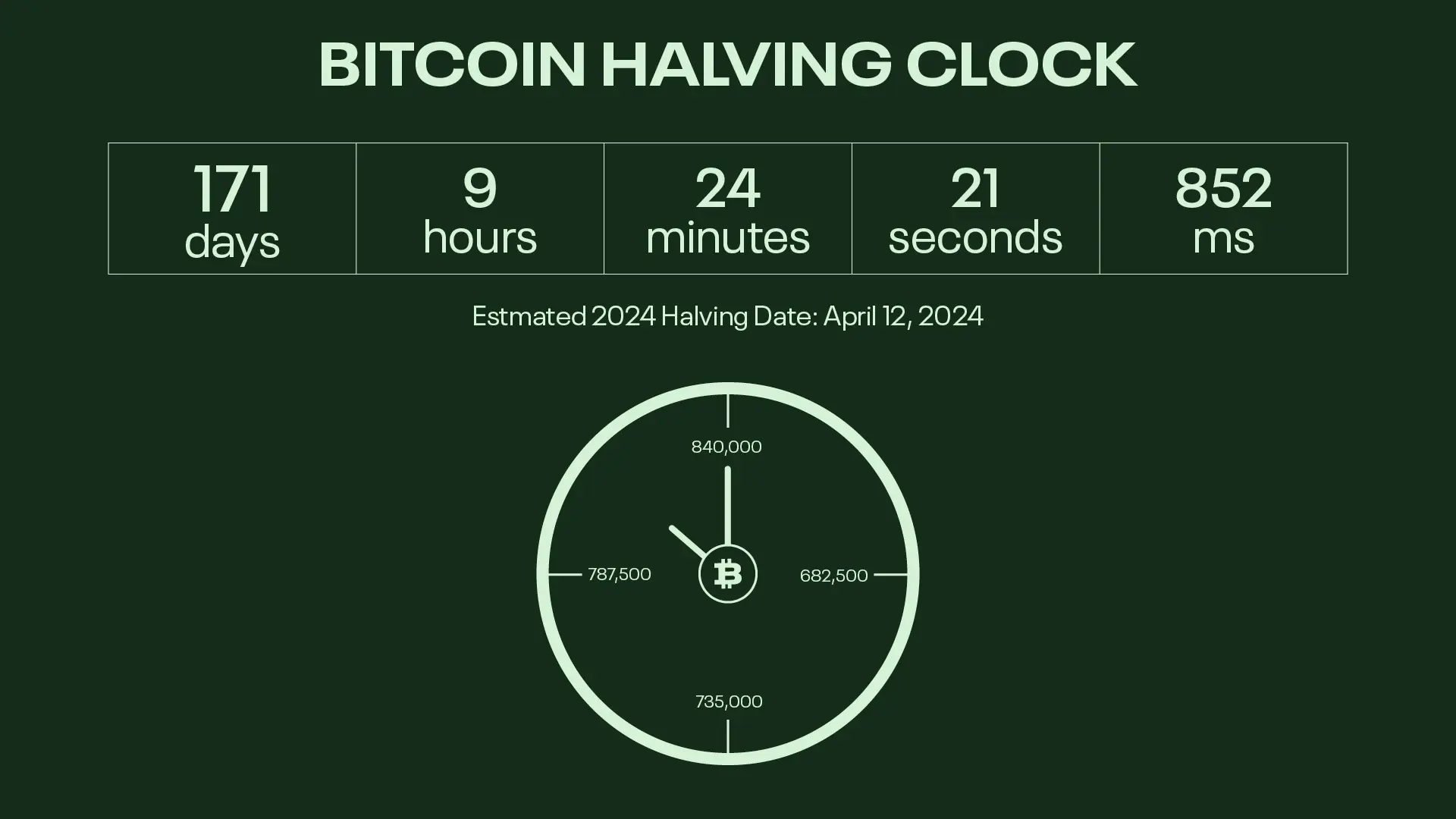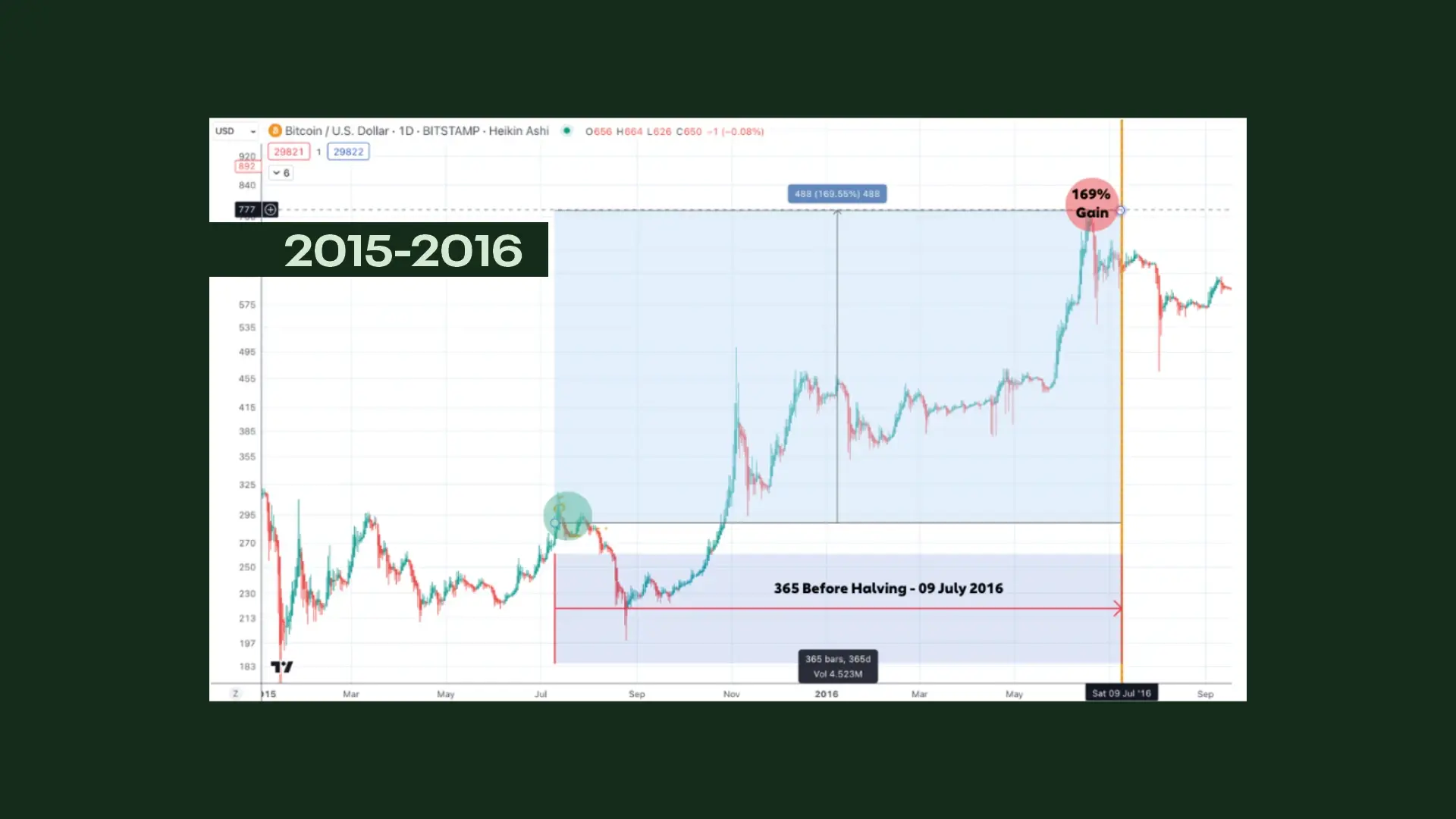How To Capitalize On Bitcoin’s Halving Volatility

How To Capitalise On Bitcoins Halving Volatility | Credit: Shutterstock
Key Takeaways
- Time-based analysis reveals patterns in Bitcoin’s pre-halving volatility.
- Historical halvings consistently show significant price surges 365 days prior.
- Halving events introduce market volatility due to altered supply dynamics.
- Strategies like historical analysis and risk management can capitalize on halving volatility.
Bitcoin’s halving event is currently set to occur in April of 2024 . Historically the halving events have been associated with significant volatility in the cryptocurrency’s price. This volatility arises from the reduction in the block reward which miners receive, effectively cutting the rate at which new Bitcoins are introduced into circulation by half.
As a result, a supply shock is felt throughout the market causing dynamics to change, often leading to speculative interest and price movements.

Halving Strategies: Using Time And Positional Trading
In this technical analysis piece, I will focus on utilizing time as a metric to make informed decisions within the context of what is happening with the price of Bitcoin. Time is a fundamental element in financial markets, playing a pivotal role in identifying patterns, trends, and cycles. By examining historical price movements over specific timeframes, traders and investors can uncover recurring patterns and cycles that provide insights into potential market shifts.
For instance, pre and post halving event cycles offer valuable data points to understand the potential trajectory of an asset’s value.
How To Take Advantage Of Bitcoin Volatility
Capitalizing on Bitcoin’s halving volatility requires a combination of understanding the historical context, strategic planning, and risk management. Here’s a list of ways the investor or trader can prepare for volatility:
- Education: The individual should do their best study Bitcoin and the Bitcoin halving
- Historical analysis: Examine price action of Bitcoin during previous halving events.
- Set clear investment goals: Determine one’s investment horizon or risk appetite.
- Use stop-loss and take-profit orders: Given the expected volatility, setting stop-loss and take-profit orders can help protect your investments from significant downturns and lock in profits.
- Stay updated: Keep an eye on news and developments related to Bitcoin and the broader crypto market.
- Risk management: Only invest what one can afford to lose.
- Stay connected with the community: Engage with other traders and investors in the crypto community.
Technical Analysis On The Bitcoin Halving And Time
Bitcoin Volatility: 365 Days Before Halving Events
The current analysis delves into a comprehensive study on price movements 365 days prior to the halving event:
2012 Pre-Year First Halving
Bitcoin’s historical price behavior presents intriguing insights when examined 365 days before halving events. This pattern consistently demonstrates that the cryptocurrency experiences substantial price surges during this period. Looking back, I can observe notable examples:

In the years leading up to the 2012 halving, an investment at $3.5 USD in Bitcoin increased by 400%, reaching $16 USD within a year. Interestingly enough the price peaked 3 months prior to the halving. Leading up to the first halving, Bitcoin was relatively new, and the market was less mature. There was significant volatility, with Bitcoin’s price seeing substantial percentage increases, as illustrated above, but the price was rising from a much lower base price.
2015 Pre-Year Second Halving
Similarly, during the 2015-2016 halving phase, purchasing Bitcoin at $300 USD resulted in a significant 169% growth, leading to a value of $777 USD within a year. Interestingly, price peaked 1 month prior to the Bitcoin halving of 2016. Which means the price kept advancing upwards with a momentarily downward move for eleven months.

By the time of the second halving, Bitcoin had gained more mainstream attention. While there was still notable volatility, the market had matured somewhat, leading to slightly more stability than the period leading up to the first halving.
2019 Pre-Year Third Halving
The trend continued in the 2019-2020 halving cycle, where investing in Bitcoin at $6,450 USD yielded a 114% increase, reaching $13,900 USD. However, this time, the price peaked within 2 months and kept on falling for the remaining 10 months after that.

Leading up to the third halving, Bitcoin’s price experienced periods of both consolidation and significant movement. The overall market was more mature, with more institutional interest, but external factors like the COVID-19 pandemic played a role in the swing in volatility seen in March 2020.
2023 Pre-Year Fourth Halving
Looking ahead to the projected 2023-2024 halving, a hypothetical purchase of Bitcoin at $29,500 USD could potentially offer a strategic opportunity. This scenario suggests that a well-timed limit order sell between approximately $49,500 to $54,000 USD might be achievable before the halving event. If realized, this would result in a potential 75% to 83% price increase.

Currently the halving is six months away, in April 2024, and the price of Bitcoin is at roughly 30K USD. The fundamentals behind Bitcoin are stronger than ever and the continued price increase is possible and seems likely.
Since this Bitcoin cycle seems similar to the 2015-2017 market cycle traders and investors can maybe expect a local top in the current rally in price to come anytime in Q1 of 2024. Seeing as the 2016 halving presented a top in the price 1 month prior to its halving.
I could potentially see a local top in March 2024. However, keep in mind that the future is unknown and this is pure speculation or an educated guess.
Bitcoin Volatility: Pre-Year Fourth Halving Strategy
A recurring characteristic is evident in the year leading up to Bitcoin’s halving: Bitcoin’s price consistently shows an increase of at least 100% within the 365 days preceding the halving events. This trend highlights the historical importance of halving cycles, positioning them as a key consideration for traders and investors aiming to capitalize on Bitcoin’s price dynamics.
Volatility May Stem From Various Other Factors
The fourth Bitcoin halving is expected to occur in 2024. While the exact outcomes of the fourth halving cannot be predicted with certainty, let’s discuss the potential factors that might influence the price of Bitcoin along with its volatility:
Supply Reduction
The primary factor of any halving is the reduction in the block reward. For the fourth halving, the block reward will decrease from 6.25 BTC to 3.125 BTC per block.
Mining Profitability
With the block reward halving, miners will earn fewer Bitcoins for the same amount of work. If the price of Bitcoin doesn’t increase proportionally, some miners might find it unprofitable to continue, leading to a potential decrease in the network’s hash rate.
Market Awareness
With the fourth halving comes wider knowledge among crypto enthusiasts and investors. This awareness can lead to increased speculation and trading activity leading up to the halving event.
Institutional Participation
The level of institutional interest and investment in Bitcoin has been growing. During the fourth halving, institutional strategies and reactions to the halving could play a significant role in price dynamics. Especially with the potential acceptance by the SEC of the ETFs.
Regulatory Environment
The regulatory landscape for cryptocurrencies is evolving. Any significant regulatory changes around the time of the halving could influence Bitcoin’s price and adoption.
Economic Factors
Broader economic conditions, such as inflation rates, interest rates, and global economic health, can influence Bitcoin’s appeal as a store of value or investment.
Market Sentiment
The collective mood and sentiment of retail and institutional investors can significantly influence price movements. Factors like media coverage, public endorsements, or criticisms of Bitcoin can sway market sentiment.
Historical Precedence
Traders and investors will likely look at the price performance and volatility patterns from previous halvings to inform their strategies. Please refer to the above time analysis provided to fully grasp this determinant of price volatility.
External Shocks
Unpredictable global events, such as geopolitical tensions, pandemics, wars, or major technological breakthroughs, can influence the crypto market and Bitcoin’s price.
Adoption Rates
The rate at which new users are adopting Bitcoin, both for speculative purposes and real-world use cases, will play a role in demand dynamics.
Conclusion
While Bitcoin’s halving events introduce heightened volatility, they also present strategic opportunities for informed traders and investors. By understanding historical patterns, staying updated, and employing sound risk management practices, one can navigate the challenges and potential rewards that these pivotal events in the Bitcoin lifecycle may present moving forward.
FAQs
What is Bitcoin’s halving and its volatility effect?
Bitcoin’s halving reduces the block reward by half. Historically, this event has introduced price volatility due to changing supply dynamics and speculative trading that this halving event breathes into the market.
How does Bitcoin’s inherent volatility impact its value?
Bitcoin’s value can fluctuate widely due to its volatility, influenced by factors like market sentiment, adoption rates, and macroeconomic events. These fluctuations can lead to rapid gains or losses.
How often does Bitcoin halving occur, and does it influence volatility?
Halving occurs approximately every four years. Leading up to and post-halving, markets often experience increased volatility due to speculative interest and changing supply perceptions.
How does halving-induced volatility affect Bitcoin miners?
Halving can introduce price volatility, affecting miner profitability. If Bitcoin’s price doesn’t compensate for the reduced block reward, some miners might find operations unprofitable, potentially altering the network’s security and hash rate.